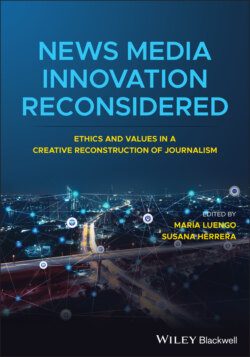Читать книгу News Media Innovation Reconsidered - Группа авторов - Страница 26
Conclusion: The Strategic Value of the Ethics of Journalistic Innovation
ОглавлениеEthics is the attempt to discern the “right action.” This means deciding what actions are justifiable in the interest of individuals and society, given that many decisions involve values, ends, and procedures that may conflict (Ward and Wasserman, 2010). Digital media ethics (DME) has become a subdomain of applied ethics for those who use digital technologies in their daily lives (Ess, 2013). DME addresses the ethical problems caused using technologies implemented in developed countries, such as cameras, smartphones, drones, bots, voice devices, navigation systems, biometric health control devices, and “the Internet of things.”
These multiple contexts of use broaden the range of ethical challenges that arise from technologies, far beyond the comparatively reduced circle of problems facing journalists or computer professionals. DME can draw clear approaches to aspects related to privacy, copyright, and technology, which help establish an accepted set of ethical practices. Some problems include “online death” (related to websites on suicides, and issues about censorship, “right to be forgotten,” etc.); issues arising from the use of massive data, such as preventive surveillance or the use of robots, from lethal weapons to “sex-bots” (Ess, 2013).
In addition to applied ethics, DME incorporates the ethical perceptions both of communities of practice and the users, whose experience contributes to the design and use of information and communication technologies. This field of ethics is increasingly hybrid and multidisciplinary—it includes contributions from engineering, economics, business, statistics, etc.—and fosters a collaborative attitude, addressing problems collectively, seeking solutions through trial and error, and making decisions in an interactive, instantaneous environment (Friend and Singer, 2007).
The ethics of innovation bring about tensions between the different elements that make up the work of journalism: privacy and freedom, integrity and commercialization, participation and control, immediacy and rigor, technology, and humanism. Some journalists use ethics as a defensive weapon when they describe an innovation as an attack on basic principles or a threat to journalistic integrity. Instead, journalists can strive in the digital setting and, at the same time, preserve the fundamental values of the profession (Friend and Singer, 2007), putting the focus on decision-making that is consistent with the ethics of the ends, the procedures, and the values.
Not all ethical problems will be quickly or easily solved. Nevertheless, trying to reach widespread solutions on issues such as privacy, the fight against misinformation, or manipulation in VR environments, together with proposals on more complex issues, will allow to rebuild journalism ethics. “Even if journalists agree to be responsible, even if they embrace principles like truth-telling and verification, they will still not be spared the task of rethinking their norms” (Ward, 2014, p. 461). The new epistemology of media innovation ethics must consider how technologies can be used to advance the communitarian mission of journalism.
News professionals in their communities of practice might contribute to project solutions, as they become part of the strategic process of newsroom innovation. Managers should have clear ethical standards and to be able to communicate them effectively to all members of the news organization, both vertically and horizontally, identifying ethical patterns that run across different media innovations, and the factors which shape change at distinct periods or in particular settings.
The media crisis arose from the penetration of digital technologies and the collapse of previous business models. However, the crisis is economic, not journalistic, the problems that journalists fear mostly coming from the pressures that arise from the lack of funding, not from innovation. Media companies have laid off staff and have cut budgets, and their journalists often lack the resources to maintain the quality of their work, as legacy media see their traditional business model crumble and many digital-only outlets fail to achieve an economically sustainable model.
When journalists try to improve the prevailing news standards and practices, they feel they can make a difference in the ethics of professional journalism. In that sense, dissatisfaction with the current situation is a key prerequisite for ethics. Within innovative newsrooms, there can be a productive energy, if there is a strategic need for change, for better ways to innovate. Therefore, dissatisfaction with the status quo and market turmoil can also be one of the driving forces for a disruptive ethics culture in which journalists take a proactive role (Ward, 2018).
The ethics of innovation, as a strategic asset for media companies, could contribute to overcoming the crisis aggravated by the COVID-19 pandemic: advertising downfall, uncertainty about business models, the growth of misinformation and, ultimately, the loss of relevance of journalism in society. In many newsrooms worldwide, innovative journalists are transforming news procedures as they face new challenges in all kind of professional situations, strengthening the public service function of journalism in democratic societies. News organizations need an innovation strategy grounded on the fundamental values of ethics, which will help build a sustainable future for journalism.
